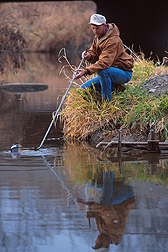This page has been archived and is being provided for reference purposes only. The page is no longer being updated, and therefore, links on the page may be invalid.
|
Read: More about the research in Agricultural Research magazine. |
Helping Farmers Meet Today's Environmental ChallengesBy Don ComisJanuary 11, 2000 A U.S. Department of Agriculture water quality project is changing the landscape of American agriculture. The program, begun in 1990 to reduce the amount of pesticides reaching groundwater, expanded three years ago to address broader environmental concerns, including harmful algal blooms. These blooms have created a widening "dead zone" in the Gulf of Mexico, where lack of oxygen kills shellfish. Pfiesteria and Red Tide algal blooms also have been implicated in fish-kills along the east coast. Reducing nitrogen loadings into the Mississippi River by 20 to 30 percent could increase oxygen levels in the Gulf by 15 to 50 percent, according to the National Science and Technology Council's recent Integrated Assessment Report. The USDA water quality program continues to show farmers how to reduce nitrogen loadings from commercial fertilizer and animal manure. Suggested approaches include:
The program originally involved large Midwestern sites called Management Systems Evaluation Areas (MSEA). The 1996 merger with USDA's Agricultural Systems for Environmental Quality brought in concerns about phosphorus, air quality, soil management, and off-site impacts. The merger also brought in Ohio's Lake Erie Basin, the Mississippi Delta region, and the eastern coastal plain. A story about the research appears in the January Agricultural Research magazine. Click here to view it on the web. Scientific contact: Dale A. Bucks, ARS National Program Leader for Water Quality and Management, Beltsville, Md., phone (301) 504-7034, fax (301) 504-6231, dab@ars.usda.gov. |

